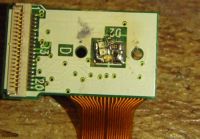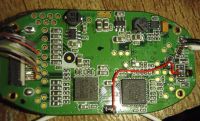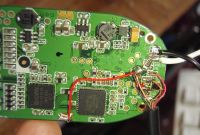
Myvu 3-D/resolutiion doubling hackery
Conundrum, Tue Nov 04 2008, 07:50PMHi all.
Seems that these video glasses can be modified to display either 3-D or 640*480 thanks to them having independent display for each eye.
Actually modifying the signals going to each display is much too complicated,
Its a cunning mod of the old style "flashing polarised glasses" trick, however instead of using a single display with flashing glasses it sends alternating scan lines of the two input video signals as a single composite.
EDIT:- this won't work due to the displays refreshing all pixels synchronously, so I will be stuck with alternating entire frames.
Also it might be amusing to try switching R/G/B LED's in time with the frame transitions so that fast moving objects will be turned into multicoloured rainbows.
pics soon :)
-A
Re: Myvu 3-D/resolutiion doubling hackery
Conundrum, Sat Nov 08 2008, 07:46PM
Hi. As promised here are the pictures.
Follow the wiring diagram seen here, you must make sure all the grounds are connected together. For noise immunity you might want to use an inline inductor from vgnd to main gnd... and don't forget the 100-600 ohm resistor.
s it is, I've replicated the "external video input" hack and everything seems OK. The buttons only work when the PCB is installed one way and be very careful not to overtighten the four screws or you will bend the PCB and potentially break it.
A mod inspired by "Journey to the Centre of the Earth 3-D" and reading up on the display datasheets, the vertical arrangement is coloured stripes. So all you would need to do is know the arrangement (typically BGR or RGB) and write your graphical driver to convert pairs of B/W lines (text say) into red/blue and green and have your eyepieces generate the appropriate colours.
Switchable 3D didn't work due to the way the existing backlight wiring is arranged (LED's in series). I had to put the SMD LED's in a ridiculously small space with 2 (GG) and
3 (RRB) and it took a few attempts to get them brightness matched.
Used 2 reds in parallel with a single blue, 680 ohm series resistor.
Greens are in series (to get the correct ratio) and brightness is one notch below maximum.
With 20/20 hindsight I should have been a bit more careful with the cable clamps. One broke (!) during testing, had to kludge a replacement with insulating tape which worked well as its held in place by plastic on all sides.
The 3-D effect is *very* intense compared with glasses+TV so this is well worth doing but I'd advise making sure you use the purest coloured SMD's you can find especially for the green to avoid crosstalk.
This is a non-switching 3D system so it has no flicker at all which is handy. The way I'd use to get 3-D from a pair of cameras is to use an MC1377 and integrate the two video streams or use a single camera with an oscillating mirror.
If you are lucky enough to purchase the next generation OLED goggles, they are a lot brighter and clearer :)
A
hope this helps, -Andre




Conundrum, Sat Nov 08 2008, 07:46PM
Hi. As promised here are the pictures.
Follow the wiring diagram seen here, you must make sure all the grounds are connected together. For noise immunity you might want to use an inline inductor from vgnd to main gnd... and don't forget the 100-600 ohm resistor.
s it is, I've replicated the "external video input" hack and everything seems OK. The buttons only work when the PCB is installed one way and be very careful not to overtighten the four screws or you will bend the PCB and potentially break it.
A mod inspired by "Journey to the Centre of the Earth 3-D" and reading up on the display datasheets, the vertical arrangement is coloured stripes. So all you would need to do is know the arrangement (typically BGR or RGB) and write your graphical driver to convert pairs of B/W lines (text say) into red/blue and green and have your eyepieces generate the appropriate colours.
Switchable 3D didn't work due to the way the existing backlight wiring is arranged (LED's in series). I had to put the SMD LED's in a ridiculously small space with 2 (GG) and
3 (RRB) and it took a few attempts to get them brightness matched.
Used 2 reds in parallel with a single blue, 680 ohm series resistor.
Greens are in series (to get the correct ratio) and brightness is one notch below maximum.
With 20/20 hindsight I should have been a bit more careful with the cable clamps. One broke (!) during testing, had to kludge a replacement with insulating tape which worked well as its held in place by plastic on all sides.
The 3-D effect is *very* intense compared with glasses+TV so this is well worth doing but I'd advise making sure you use the purest coloured SMD's you can find especially for the green to avoid crosstalk.
This is a non-switching 3D system so it has no flicker at all which is handy. The way I'd use to get 3-D from a pair of cameras is to use an MC1377 and integrate the two video streams or use a single camera with an oscillating mirror.
If you are lucky enough to purchase the next generation OLED goggles, they are a lot brighter and clearer :)
A
hope this helps, -Andre




Re: Myvu 3-D/resolutiion doubling hackery
..., Fri Jan 02 2009, 07:04AM
It looks like you made it to hack a day
Did you ever managed to make any more progress?
..., Fri Jan 02 2009, 07:04AM
It looks like you made it to hack a day

Did you ever managed to make any more progress?
Re: Myvu 3-D/resolutiion doubling hackery
Conundrum, Sat Jun 20 2009, 11:02PM
Yeah, I am ready to test (as soon as new soldering iron shows up) my 3-D RatCam (tm) using two B/W cameras synchronised using a PLL and varicap diode.
To simplify things and reduce bandwidth to sensible levels I am using the odd/even field technique which allows me to merge two video signals while switching colours on the Myvu to send L and R frames to their correct sides.
This also allows me to do clever tricks such as using frame sequential IR illumination wavelengths to get pseudo-colour as well as allowing a head up display at a different level to the 3-D.
-A
Conundrum, Sat Jun 20 2009, 11:02PM
Yeah, I am ready to test (as soon as new soldering iron shows up) my 3-D RatCam (tm) using two B/W cameras synchronised using a PLL and varicap diode.
To simplify things and reduce bandwidth to sensible levels I am using the odd/even field technique which allows me to merge two video signals while switching colours on the Myvu to send L and R frames to their correct sides.
This also allows me to do clever tricks such as using frame sequential IR illumination wavelengths to get pseudo-colour as well as allowing a head up display at a different level to the 3-D.
-A
Print this page